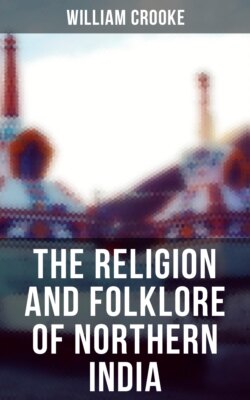Читать книгу The Religion and Folklore of Northern India - William Crooke - Страница 10
На сайте Литреса книга снята с продажи.
Sûraj Nârâyan, the Sun Godling.
ОглавлениеTable of Contents
The first and greatest of the “pure” godlings is Sûrya or Sûraj Nârâyan, the Sun godling. He is thus regarded as Nârâyana or Vishnu occupying the sun. A curiously primitive legend represents his father-in-law, Viswakarma, as placing the deity on his lathe and trimming away one-eighth of his effulgence, leaving only his feet. Out of the blazing fragments he welded the weapons of the gods. Sûrya was one of the great deities of the Vedic pantheon: he is called Prajapati or “lord of creatures:” he was the son of Dyaus, or the bright sky. Ushas, the dawn, was his wife, and he moves through the sky drawn by seven ruddy mares. His worship was perhaps originally connected with that of fire, but it is easy to understand how, under a tropical sky, the Indian peasant came to look on him as the lord of life and death, the bringer of plenty or of famine. If one interpretation of the rite be correct, the Holî festival is intended as a means of propitiating sunshine. He is now, however, like Helios in the Homeric mythology, looked on as only a godling, not a god, and even as a hero who had once lived and reigned on earth.
As far as the village worship of Sûraj Nârâyan goes, the assertion, which has sometimes been made, that no shrine has been erected in his honour is correct enough; and there is no doubt that images of Sûrya and Aditya are comparatively rare in recent epochs. But there are many noted temples dedicated to him, such as those at Taxila, Gwâlior, Gaya, Multân, Jaypur, and in the North-Western Provinces at Indor, Hawalbâgh, Sûrya Bhîta and Lakhmipur.7 His shrine at Kanârak in Orissa near that of Jagannâth, is described as one of the most exquisite memorials of Sun-worship in existence.8 Mr. Bendall recently found in Nepâl an image dedicated to him as late as the eleventh century.9 There is a small shrine in his honour close to the Annapûrna temple in Benares, where the god is represented seated in a chariot drawn by seven horses, and is worshipped with the fire sacrifice (homa) in a building detached from the temple.10
In the time of Sankara Achârya (A.D. 1000) there were six distinct sects of Sun-worshippers—one worshipping the rising sun as identified with Brahma; the second the meridian sun as Siva; the third the setting sun as Vishnu; the fourth worshippers of the sun in all the above phases as identified with the Trimurti; the fifth worshippers of the sun regarded as a material being in the form of a man with a golden beard and golden hair. Zealous members of this sect refused to eat anything in the morning till they had seen the sun rise. The last class worshipped an image of the sun formed in the mind. These spent all their time meditating on the sun, and were in the habit of branding circular representations of his disc on their foreheads, arms and breasts.11
The Saura sect worship Sûryapati as their special god. They wear a crystal necklace in his honour, abstain from eating salt on Sundays and on the days when the sun enters a sign of the zodiac. They make a frontal mark with red sandars, and nowadays have their headquarters in Oudh.12
Another sect of Vaishnavas, the Nîmbârak, worship the sun in a modified form. Their name means “the sun in a Nîm tree” (Azidirachta Indica). The story of the sect runs that their founder, an ascetic named Bhâskarâchârya, had invited a Bairâgi to dine with him, and had arranged everything for his reception, but unfortunately delayed to call his guest till after sunset. The holy man was forbidden by the rules of his order to eat except in the day-time, and was afraid that he would be compelled to practise an unwilling abstinence; but at the solicitation of his host, the Sun god, Sûraj Nârâyan, descended on the Nîm tree under which the feast was spread and continued beaming on them until dinner was over.13 In this we observe an approximation to the Jaina rule by which it is forbidden to eat after sunset, lest insects may enter the mouth and be destroyed. This over-strained respect for animal life is one of the main features of the creed. As a curious parallel it may be noted that when an Australian black-fellow wishes to stay the sun from going down till he gets home, he places a sod in the fork of a tree exactly facing the setting sun; and an Indian of Yucatan, journeying westward, places a stone in a tree, or pulls out some of his eye-lashes and blows them towards the sun.14
The great Emperor Akbar endeavoured to introduce a special form of Sun-worship. He ordered that it was to be adored four times a day: in the morning, noon, evening, and midnight. “His majesty had also one thousand and one Sanskrit names of the sun collected, and read them daily, devoutly turning to the sun. He then used to get hold of both ears, and turning himself quickly round, used to strike the lower ends of his ears with his fists.” He ordered his band to play at midnight, and used to be weighed against gold at his solar anniversary.15
